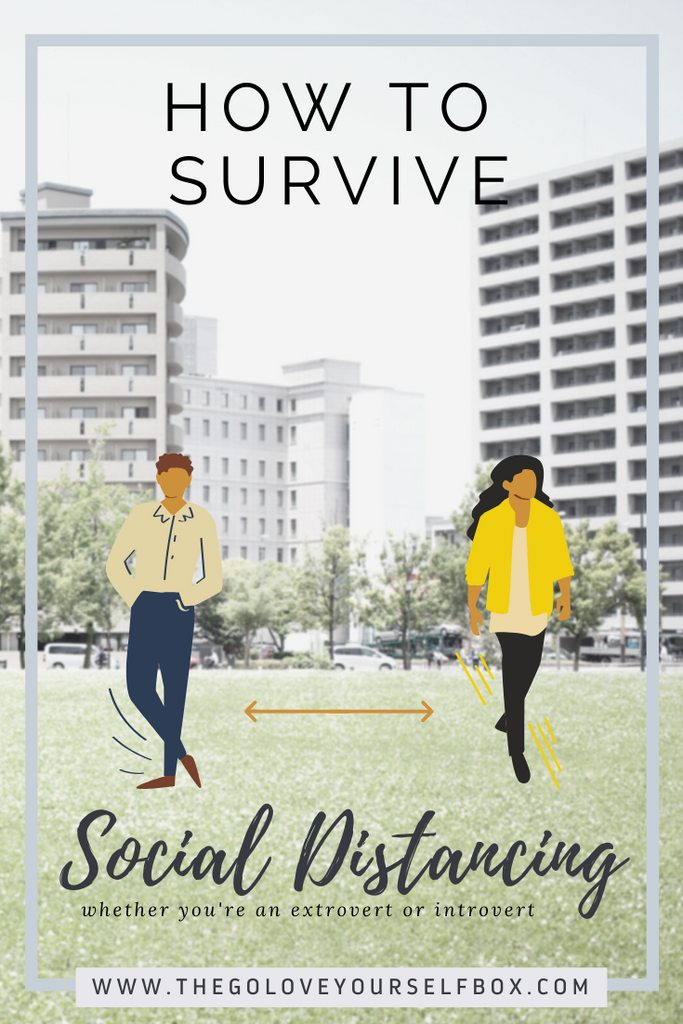When I ask people how they’re doing in the midst of this global pandemic we’re in, I find myself getting two semi-predictable responses:
- I’m an extrovert. I think I may be actively dying from isolation.
- I’m an introvert. I was made for this. And I also feel guilty AF for feeling so okay.
But regardless of how you identify, there are a few things we could all do to ease the transition into our new temporary lifestyles.
1) Abandon your identity as an introvert or extrovert.
Most scientists agree that there’s no such thing as a pure introvert or extrovert, but that we fall somewhere on a continuum and that where we fall on that continuum can change over time and in different contexts. Generally, we use titles like these to help us create easy distinctions for others and to make it easier for ourselves and others to make sense of our behaviors. But consider this: how is this identity serving you? What does saying it do for you right now? It may actually be doing more harm than good.
2) Abandon the misconception that being extroverted means you get your energy from other people.
This has been debunked, but it’s dying hard. We all need and crave human interaction. We all enjoy being with other people. We all want to belong and yes, we all enjoy being social. And yes, this stands for introverts just as much as extroverts! If the introvert/extrovert distinction is helpful for you, then the distinction that may actually be more helpful here is one of stimulation: those who rate themselves as more introverted are more sensitive to stimulation and therefore tend to be overstimulated from prolonged social interaction (in addition to other sources). Instead of noticing the lack of people and social interactions, consider noting the quality and quantity of the stimulation in your day. (Other unhelpful misconceptions to let go of while you’re at it: extroverts love public speaking and introverts are all shy.)
3) Rethink “social distancing” and get social (at a safe distance!)
The term social distancing isn’t doing us any favors, nor does it super accurately describe the physical distancing we need to be doing. Set up Facetime dates with your friends, Zoom your parents, set up virtual play dates for the kiddos and virtual happy hours and board game nights for you (jackboxgames.com seems to have been made for this!). Join a virtual co-working group (GLY now has one for community members!) or a virtual GLY Women’s Circle. Lean out your window and say hi to your neighbors, leave side-walk chalk notes on driveways, and learn your mailman’s schedule so you can say hi and offer a “thank you” for their years of service. Distance does not have to mean isolation and being alone doesn’t have to be lonely.
4) Figure out what you really need, and get it.
In the same way we sometimes mistake thirst or tiredness for hunger, we may mistake our need for stimulation as a need for human contact. There are, thankfully, lots of ways to work with our need for stimulation:
- Are you feeling antsy? Get in some exercise. Try a few minutes of HIIT to get your heart rate up.
- Craving a change of scenery? Get out of the house, if you can safely, and go on a walk. To add more stimulation, make it a run, call a friend, listen to a podcast, or be extra mindful: people watch in the park (again, at a safe distance!), pay extra attention to the birds flying, and the flowers blooming defiantly in the midst of it all. Can’t get out? Try a virtual museum tour.
- Need to hear another voice? Turn on a movie, even if it just plays in the background while you cook and clean and tend to other things.
- Is your mind racing? Turn inward. Journal. Quiet an anxious or nervous mind with meditation. Feeling too fidgety? Start with a moving meditation, yoga, guided visualizations, chanting, or even a virtual Breath of Fire practice online.
- Want some novelty? Tap into your creativity. Cook. Sing at the top of your lungs. Write the book that’s been begging to be written. Do things differently: sleep upside-down in your bed, add grapefruit to your morning water, change up your morning routine, move your furniture, etc.
- Looking for a challenge? Build a puzzle, try sudoku or crosswords, learn a new language, start (or finish!) a home renovation project, learn how to create and tend a victory or guerilla garden.
- Yearning to feel purposeful? Recognize that staying home isn’t passive – it’s actively helping. Donate to non-profits who are responding. Offer to read virtually to students and young ones who are home from school. Support small and local businesses. Check in on the most vulnerable in your community: grandparents, those with compromised immune systems, and see if there’s anything they need.
This time isn’t particularly easy for anyone, however, by getting to know yourself – and what you really need – we can all help each other to survive and thrive.
